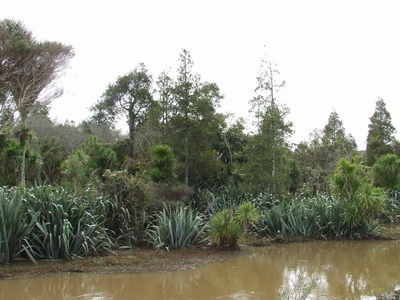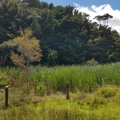Wetlands
What is a wetland?
The term 'wetland' covers habitats where the land is covered in, or saturated by water for at least some of the time.
Wetlands occur in areas where surface water collects or where underground water seeps through to the surface. There are many different kinds of wetland, including swamps, bogs, marshes, gumlands, saltmarshes, mangroves and some river, lake and stream edges.
Go to our factsheets about the different types of wetlands and how to look after them
Why wetlands are important
In the past, many people didn't recognise the true value of wetlands and consequently nearly all of them have been converted to pasture or urban use. Wetlands help prevent flooding and improve water quality, as well as providing the necessary habitat for a number of unique species of plants and animals, many of which are rare. These include the endangered grey duck, Australasian bittern, New Zealand dabchick and freshwater fish such as mudfish and whitebait species. Conserving and restoring wetlands will provide many benefits to the wider environment.
Giant 'sponges'
Wetlands act as giant sponges, helping to soak up water and improve water quality. Plants in wetlands slow the flow of water off the land so that, in times of flood, more can be absorbed into the soil and taken up by the plant life. In summer, stored water is slowly released from wetlands, maintaining water flows.
Cleansing the system
Bacteria in damp wetland soils contribute to cleaner water by absorbing and breaking down nutrients from fertilisers, chemicals and animal wastes. About 90% of the nitrogen contained in farm run-off can be broken down in wetlands. Wetland plants also trap waterborne sediment, preventing silt entering streams and harbours. Silt clouds the water and clogs fish gills, while phosphorus bound to the silt particles in the water increases algal and weed growth. Cleaner water is better for livestock and wildlife.
Food sources
Wetlands are among the most productive places on Earth, providing an enormous food source for fish, birds and other animals. They contain micro-organisms (fungi and bacteria) which efficiently decompose and recycle nutrients.
Cultural treasures
Wetlands are also important to Māori, featuring in the history and culture of many hapū. Wetland plants such as kuta (reeds) are traditional materials for clothing, mats, medicine and dyes. Wetland animals, especially tuna (eels) and kewai (crayfish) are valuable food sources.
What can you do to help look after our wetlands?
Fencing stock out of wetlands is a good starting point, as they can pug the margins, add sediment and nutrients and damage habitat for plants and animals. When you fence, you can create a wide buffer zone that you could then plant with appropriate native species.
Control pest plants and animals , especially within your fenced area where the reduction of stock grazing will allow weeds to grow.
Remember that Northland Regional Council has rules governing what can be done in and near significant wetlands (that is, most wetlands in Northland). This includes drainage affecting water flows into or out of the wetland, building structures, clearing or excavating. Before you start any work, get advice from us.
What rules apply to wetlands?
Because they are so important, there are a number of rules that apply to activities within and near to wetlands. These activities include earthworks, vegetation clearance, building structures, drainage, taking water and requirements to keep livestock out of wetlands. There are rules are in our regional plan and rules that have been set by central government - for more information see The Freshwater Plan and Wetland rules.
If you want help identifying a wetland or are unsure which rules apply, please get in touch with us.
Funding
Applications for grants to support riparian and wetland fencing are closed. No further inquiries will be taken.
We're proposing to pause grant funding from the Environment Fund for 2024/25 and 2025/26 while staff focus on implementing new regulations. This will have no impact on rates, with any retained funds being used to support the new regulatory requirements.
Want more information?
For more information about wetland types, the plants and animals that live there, and protection and restoration, check out our publications in the resource library.
Contact a land management advisor
Contact a land management advisor for more information on 0800 002 004. One of our land management team can visit your property and offer free advice on funding and sustainable land management actions that could improve biodiversity on your property.
 Rotu Bottleneck Swamp Forest, Dargaville.
Rotu Bottleneck Swamp Forest, Dargaville.
Top wetlands project
Ranking of top wetlands in the Northland Region (PDF, 1.5MB)
Want to visit a wetland in Northland?
The National Wetland Trust is developing a directory of wetlands across New Zealand that have public access and facilities such as boardwalks, interpretation panels, picnic areas, and viewing hides.
If you would like to find a wetland in your region, visit the National Wetland Trust's website to find the online directory.

